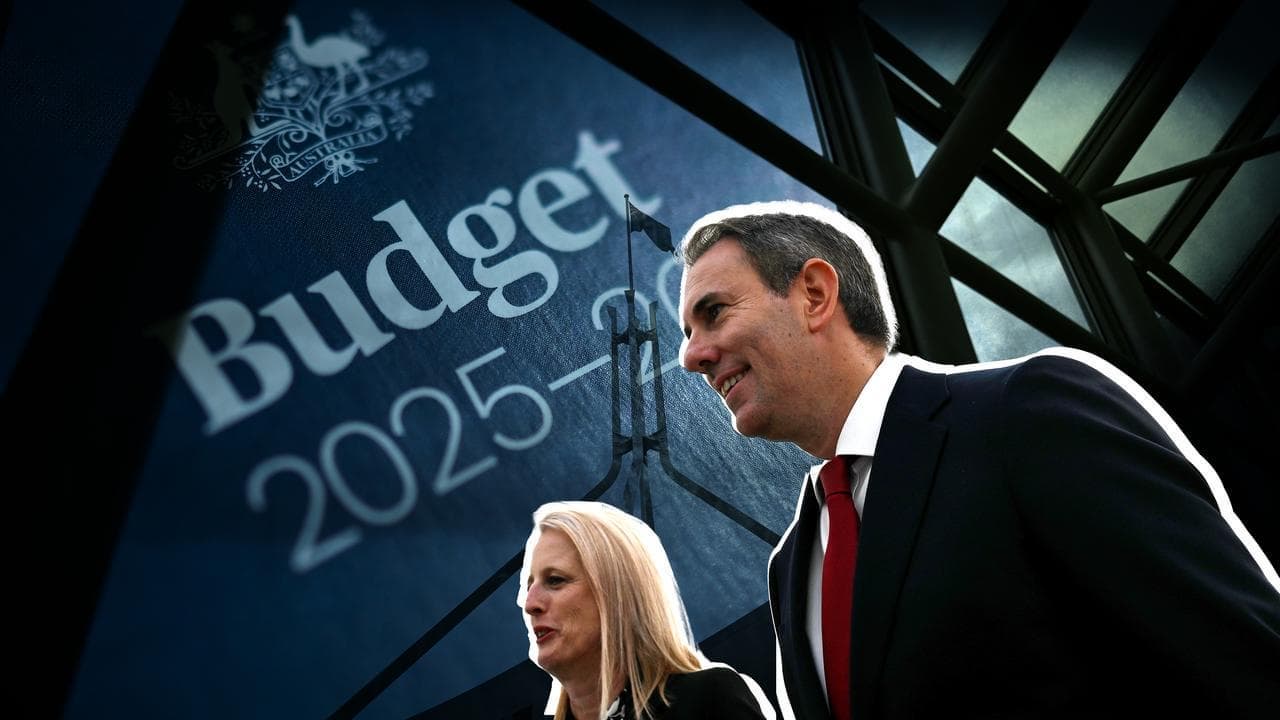WHAT WAS CLAIMED
Wind turbine decommissioning costs rest with the landholder.
OUR VERDICT
Mixture. While in certain circumstances the landholder could be liable, the costs do not automatically rest with them.
AAP FACTCHECK – Barnaby Joyce has sounded the alarm over the decommissioning costs of wind turbines, claiming landholders will be liable to foot the bill.
He criticised a former NSW government minister for leaving decommissioning costs on the "farmers' chit" and said landholders, rather than turbine owners, could be left to pick up the bill.
While there is some truth to Mr Joyce's claim, it also contains errors and excludes important context.
The Nationals MP was involved in an energy debate with Climate Change Authority chair Matt Kean at the Daily Telegraph Bush Summit in August.
 Climate Change Authority chair Matt Kean was in discussion with Barnaby Joyce. (Steven Markham/AAP PHOTOS)
Climate Change Authority chair Matt Kean was in discussion with Barnaby Joyce. (Steven Markham/AAP PHOTOS)
During the event, Mr Joyce spoke about the impact of renewable projects on farmers, questioning Mr Kean, the former NSW energy minister, on why the government didn't offer to pay for the decommissioning of renewable energy projects.
"If you believe this is so virtuous, when you were the minister… why didn't you say, well then, the government will be responsible for the decommissioning and rehabilitation of the land after the swindle factories, the wind towers, become obsolete? Why did you leave that on the farmer's chit?" he said.
"Chit" is a term used to describe the official recording of a sum owned.
Journalist John Rolfe, who was the event moderator, asked Mr Joyce if there was evidence farmers have had to pay for decommissioning.
Mr Rolfe also cited the Clean Energy Council website, which states that the project owner is responsible for decommissioning, not the landowner.
Mr Joyce responded by saying farmers were looking at their contracts and realising they were responsible for decommissioning costs.
 Mr Joyce was challenged over his claim by the event moderator. (Mick Tsikas/AAP PHOTOS)
Mr Joyce was challenged over his claim by the event moderator. (Mick Tsikas/AAP PHOTOS)
He also raised a scenario in which landowners could be left to pay the bill, even if the owner was liable in the contract.
"You'll have a company in Shanghai, and it gets a DA through and then it flips the deal, and then it flips the deal again … you're left with a $2 shelf company which is apparently going to decommission and rehabilitate the site," Mr Joyce said.
Experts told AAP FactCheck while there is nothing in legislation or regulations to state an owner must take responsibility for all decommissioning costs prior to approval, it is unlikely an application would be approved without this in place.
The Clean Energy Council confirmed to AAP FactCheck that there was no legislative or regulatory requirement, but said the industry was open to reforms along these lines.
Several state governments (the authorities that approve such projects) said decommissioning costs were a matter for the relevant parties involved in the contract process.
Ty Christopher, director of the University of Wollongong's Energy Futures Network, agreed that while there is no specific requirement, "projects are rarely approved without the project proponent committing to decommissioning costs and process".
In several development consents viewed by AAP FactCheck for the Bango, Thunderbolt and Bowmans Creek wind farms (in NSW), the project owner is named as responsible for decommissioning.
However, Mr Joyce was correct in his claim that there is potential for landowners to be left with the bill in the event of default by the project owner.
The same concern was raised in the 2022 annual report of the Australian Energy Infrastructure Commissioner, which Mr Joyce's office cited when asked by AAP FactCheck for evidence.
While the report notes "most planning permits state that decommissioning responsibilities rest with the project owner", it adds liability may ultimately rest with the landholder in the event of default by the project owner.
"Project operators/owners may change many times during the life of the project, and this may put at risk any long-term funding arrangements to cover the costs of decommissioning …," the report says.
 The decommissioning of a wind turbine is an expensive process. (Mick Tsikas/AAP PHOTOS)
The decommissioning of a wind turbine is an expensive process. (Mick Tsikas/AAP PHOTOS)
The report warns that decommissioning costs, predicted to be between $400,000 and $600,000 per turbine, could end up exceeding the total income generated for the landholder over the 25-year period of operation.
"The decommissioning of some of Australia's initial wind farm projects will need to commence in the next few years," the report concludes. "This is likely to result in increased focus on concerns about this topic."
One way to combat this, the report states, is for the project owner to set up a security bond, trust or sinking fund, or bank guarantee.
Mark Twidell, who sits on the Industry Advisory Board of the UNSW Energy Institute, said it was unlikely owner default would result in a landholder footing the bill, given the value of the existing sites.
"The owners of Australia's wind farms are generally in the sector for the long term," Professor Twidell told AAP FactCheck.
"Wind and solar will continue to generate past their (typically) 20-25-year financial life and the option to repower the site with upgraded technology is a more likely outcome than decommissioning."
Given the residual value of a site, even if a project owner did default, Prof Twidell added, it would be a financially attractive option for another owner to step in, take on the liabilities and seek to repower the site.
The Verdict
Mixture – The claim includes accurate information but also significant errors or problems.
AAP FactCheck is an accredited member of the International Fact-Checking Network. To keep up with our latest fact checks, follow us on Facebook, Twitter and Instagram.












